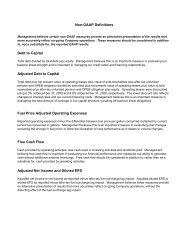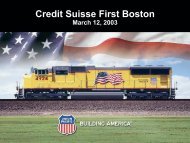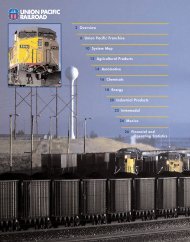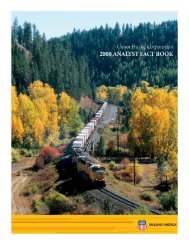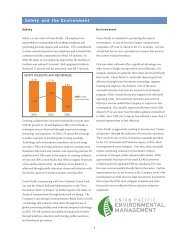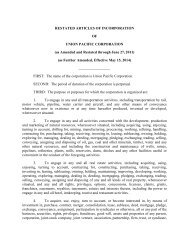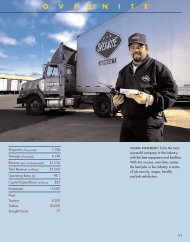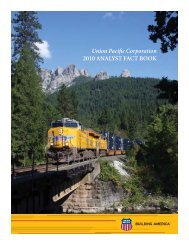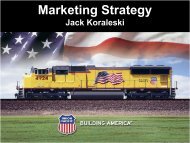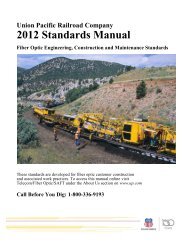Form 10-K - Union Pacific
Form 10-K - Union Pacific
Form 10-K - Union Pacific
Create successful ePaper yourself
Turn your PDF publications into a flip-book with our unique Google optimized e-Paper software.
which all items with similar characteristics, use, and expected lives are grouped together in asset classes,<br />
and are depreciated using composite depreciation rates. The group method of depreciation treats each<br />
asset class as a pool of resources, not as singular items. We currently have more than 60 depreciable<br />
asset classes, and we may increase or decrease the number of asset classes due to changes in<br />
technology, asset strategies, or other factors.<br />
We determine the estimated service lives of depreciable railroad assets by means of depreciation studies.<br />
We perform depreciation studies at least every three years for equipment and every six years for track<br />
assets (i.e., rail and other track material, ties, and ballast) and other road property. Our depreciation<br />
studies take into account the following factors:<br />
<br />
<br />
<br />
<br />
Statistical analysis of historical patterns of use and retirements of each of our asset classes;<br />
Evaluation of any expected changes in current operations and the outlook for continued use of<br />
the assets;<br />
Evaluation of technological advances and changes to maintenance practices; and<br />
Expected salvage to be received upon retirement.<br />
For rail in high-density traffic corridors, we measure estimated service lives in millions of gross tons per<br />
mile of track. It has been our experience that the lives of rail in high-density traffic corridors are closely<br />
correlated to usage (i.e., the amount of weight carried over the rail). The service lives also vary based on<br />
rail weight, rail condition (e.g., new or secondhand), and rail type (e.g., straight or curve). Our<br />
depreciation studies for rail in high density traffic corridors consider each of these factors in determining<br />
the estimated service lives. For rail in high-density traffic corridors, we calculate depreciation rates<br />
annually by dividing the number of gross ton-miles carried over the rail (i.e., the weight of loaded and<br />
empty freight cars, locomotives and maintenance of way equipment transported over the rail) by the<br />
estimated service lives of the rail measured in millions of gross tons per mile. For all other depreciable<br />
assets, we compute depreciation based on the estimated service lives of our assets as determined from<br />
the analysis of our depreciation studies. Changes in the estimated service lives of our assets and their<br />
related depreciation rates are implemented prospectively.<br />
Under group depreciation, the historical cost (net of salvage) of depreciable property that is retired or<br />
replaced in the ordinary course of business is charged to accumulated depreciation and no gain or loss is<br />
recognized. The historical cost of certain track assets is estimated using (i) inflation indices published by<br />
the Bureau of Labor Statistics and (ii) the estimated useful lives of the assets as determined by our<br />
depreciation studies. The indices were selected because they closely correlate with the major costs of<br />
the properties comprising the applicable track asset classes. Because of the number of estimates<br />
inherent in the depreciation and retirement processes and because it is impossible to precisely estimate<br />
each of these variables until a group of property is completely retired, we continually monitor the<br />
estimated service lives of our assets and the accumulated depreciation associated with each asset class<br />
to ensure our depreciation rates are appropriate. In addition, we determine if the recorded amount of<br />
accumulated depreciation is deficient (or in excess) of the amount indicated by our depreciation studies.<br />
Any deficiency (or excess) is amortized as a component of depreciation expense over the remaining<br />
service lives of the applicable classes of assets.<br />
For retirements of depreciable railroad properties that do not occur in the normal course of business, a<br />
gain or loss may be recognized if the retirement meets each of the following three conditions: (i) is<br />
unusual, (ii) is material in amount, and (iii) varies significantly from the retirement profile identified through<br />
our depreciation studies. A gain or loss is recognized in other income when we sell land or dispose of<br />
assets that are not part of our railroad operations.<br />
When we purchase an asset, we capitalize all costs necessary to make the asset ready for its intended<br />
use. However, many of our assets are self-constructed. A large portion of our capital expenditures is for<br />
replacement of existing track assets and other road properties, which is typically performed by our<br />
employees, and for track line expansion and other capacity projects. Costs that are directly attributable to<br />
capital projects (including overhead costs) are capitalized. Direct costs that are capitalized as part of selfconstructed<br />
assets include material, labor, and work equipment. Indirect costs are capitalized if they<br />
clearly relate to the construction of the asset.<br />
General and administrative expenditures are expensed as incurred. Normal repairs and maintenance,<br />
including rail grinding, are also expensed as incurred, while costs incurred that extend the useful life of an<br />
asset, improve the safety of our operations or improve operating efficiency are capitalized. These costs<br />
75



